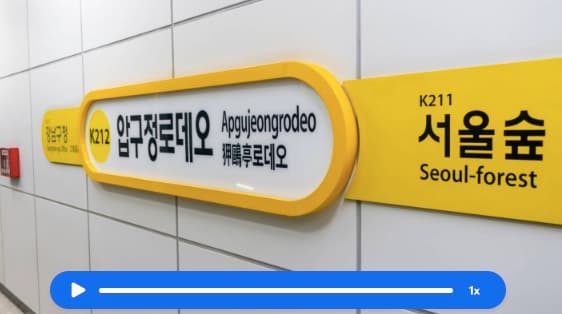How to Read in Korean
Let’s learn how to read in Korean and some important basic rules on reading Korean!
Author:

Keehwan Kim
Hangul is made up of 19 consonants and 21 vowels, so once you have learned all the letters, you are ready to read Korean ( check out our article on Hangul). However, while most Korean words are simple to read, there are certain combinations which can make reading quite tricky. Learning a few basic rules will help you sound natural as you read Korean. In this article, we will give you a full guide on how to read Korean.
Consonant + vowel combinations
Korean is written by forming blocks of syllables, and the basic structure of Korean syllables is a consonant and a vowel. Here is an example:
가
[ga]
This syllable is made up of the consonant ㄱ [g] and the vowel ㅏ[a], so this syllable 가 is pronounced [ga]. Some vowels, such as ㅏ, have a vertical bar, and these vowels are positioned next to the consonant. However, some vowels, such as ㅜ, have a horizontal bar, and these vowels are positioned below the consonant.
구
[gu]
ㅜ is pronounced [u], so this is pronounced [gu].
There are also vowels that combine two vowels together. For example, if we combine the vowels ㅗ and ㅏ together, we form ㅘ [wa]. This kind of vowel wraps around the consonant, as you can see in the example below:
과
[gwa]
The following table shows some examples of Hangul syllable formation.
Syllable examples
| Korean | Romanization |
|---|---|
| 보 | [bo] |
| 재 | [jae] |
| 씨 | [ssi] |
| 처 | [cheo] |
| 왜 | [wae] |
| 뭐 | [mwo] |
Consonant + vowel + consonant combinations
We can add a third consonant in a Korean syllable, and this final consonant is called 받침 [batchim]. The final consonant can sometimes cause a bit of confusion as it is often pronounced differently from how it would be pronounced as the initial consonant in a syllable.
Of the 19 consonants, only 3 (ㅃ, ㅉ, ㄸ) are not used as 받침. Of the remaining 16, 3 consonants are pronounced in the same way as they are as word initial consonants, and they are ㅁ, ㄴ, and ㄹ. ㅇ is pronounced as an [ng] sound, and there are three groups of consonants which are all pronounced in the same way as final consonants. These are shown in the following chart:
Final consonant pronunciation
| Korean | Final consonant sound |
|---|---|
| ㄱ, ㅋ, ㄲ | [k] |
| ㄷ, ㅌ, ㅅ, ㅆ, ㅈ, ㅊ, ㅎ | [t] |
| ㅂ, ㅍ | [p] |
| ㅁ | [m] |
| ㄴ | [n] |
| ㄹ | [l] |
| ㅇ | [ng] |
As you can see, the three groups of consonants are pronounced as [k], [t], and [p] sounds when they’re used as final consonants.
The following table shows how consonants are used as 받침 in Hangul syllables and how each Hangul syllable is pronounced.
Final consonant syllable examples
| Korean | Romanization | English |
|---|---|---|
| 밖 | [bak] | outside |
| 잣 | [jat] | pine nut |
| 옆 | [yeop] | side |
| 봄 | [bom] | spring |
| 간 | [gan] | liver |
| 절 | [jeol] | temple |
| 강 | [gang] | river |
Double consonants
Korean has five double consonants: ㄲ, ㄸ, ㅃ, ㅆ, ㅉ. They are called double consonants as they combine two of the same consonants, and pronunciation of these consonants can be tricky for many English speakers.
When you pronounce these consonants at the beginning of a word, you have to strain the muscles around your mouth a little and push out the sound with more force than the other sounds. Because of this tensing of muscles, we sometimes call double consonants ‘tense consonants.’
Double consonant vs basic consonant
| Double consonant | Basic consonant |
|---|---|
| 까 | 가 |
| 따 | 다 |
| 빠 | 바 |
| 싸 | 사 |
| 짜 | 자 |
Linking sound
Perhaps the most important rule in Korean pronunciation is the concept of linking sound. If the following syllable begins with the consonant ‘ㅇ’, then the final consonant of the first syllable links with it. Here’s an example:
받아요
[ba-da-yo]
In this syllable, the second syllable (아) begins with ㅇ, so the final consonant (ㄷ) in the first syllable (받) links with the second syllable. Also, although ㄷ as a final consonant is pronounced as a [t] sound, when it links with the next syllable, it’s pronounced as the initial consonant sound [d].
The table below shows some examples of Korean words where the final consonant links with the following syllable that begins with ㅇ.
Linking sound examples
| Korean | Romanization | English |
|---|---|---|
| 밖에서 | [ba-kke-seo] | on the outside |
| 찾아요 | [cha-ja-yo] | to find |
| 앞으로 | [a-peu-ro] | towards forward |
| 좋아요 | [jo-a-yo] | to be good |
| 봄에 | [bo-me] | in spring |
| 번역 | [beo-nyeok] | translation |
| 팔에 | [pa-re] | on the arm |
| 강으로 | [gang-eu-ro] | towards the river |
There are some exceptions to the rule. For example, in 좋아요, even though the second consonant begins with ㅇ (아), the final consonant ㅎ does not link with 아. Instead, ㅎ becomes silent.
In 강으로, ㅇ in 강 is pronounced as an ‘ng’ sound, so we don’t link ㅇ with the syllable 으.
Forming aspirated sounds
ㅎ is technically a [t] sounding final consonant. However, how the ㅎ final consonant is pronounced depends on the consonant used in the next syllable.
As we saw earlier, in 좋아요, ㅎ is silent when the following syllable begins with ㅇ, but the other important rule is that if the syllable after ㅎ final consonant begins with ㄱ, ㄷ, ㅂ, or ㅈ, then the combination of these consonants and ㅎ forms an aspirated sound. Aspirated sounds are consonant sounds which we produce by expelling air. In Korean, these sounds are ㅋ, ㅌ, ㅍ, and ㅊ.
The following table shows how ㅎ combines with certain consonants to form aspirated sounds.
Aspirated sound formation
| Final consonant | Aspirated sound |
|---|---|
| ㅎ + ㄱ | ㅋ |
| ㅎ + ㄷ | ㅌ |
| ㅎ + ㅈ | ㅊ |
*In Korean, ㅎ final consonant is never followed by ㅂ
Examples words (ㅎ + ㄱ, ㄷ, ㅈ)
| Word | Pronunciation | English |
|---|---|---|
| 직행 | [지캥] | nonstop, express |
| 맏형 | [마텽] | oldest brother |
| 잡히다 | [자피다] | to be caught |
| 맞히다 | [마치다] | to be correct |
So in these words, the ㄱ, ㄷ, ㅂ, ㅈ final consonants combine with ㅎ in the following syllable to form the aspirated sounds ㅋ, ㅌ, ㅍ, ㅊ.
Understanding 겹받침
겹받침 [gyeop-bat-chim] refers to final consonants that are made up of two different consonants. There are altogether 11 types of 겹받침, and the basic rule of 겹받침 is that we read one of the consonants aloud and the other is silent. For eight of the 겹받침, we read the first consonant aloud, and for the other three, we read the second consonant aloud, as seen in the following two tables.
겹받침 (Reading the first consonant)
| 겹받침 | Korean | Pronunciation |
|---|---|---|
| ㄳ | 넋 [넉] | [넉] |
| ㄵ | 앉 | [안] |
| ㅄ | 값 | [갑] |
| ㄼ | 짧 | [짤] |
| ㄽ | 곬 | [골] |
| ㄾ | 핥 | [할] |
| ㄶ | 많 | [만] |
| ㅀ | 싫 | [실] |
겹받침 (Reading the second consonant)
| 겹받침 | Korean | Pronunciation |
|---|---|---|
| ㄺ | 닭 | [닥] |
| ㄻ | 젊 | [점] |
| ㄿ | 읊 | [읖] |
When these 겹받침 are followed by a syllable that begins with ㅇ, then we generally read the first consonant in 겹받침, and the second consonant links with the following syllable.
겹받침 linking sound examples
| 겹받침 | Korean | Pronunciation | English |
|---|---|---|---|
| ㄵ | 앉아요 | [안자요] | to sit |
| ㄼ | 짧은 | [짤븐] | short |
| ㅄ | 값이 | [갑시] | the price |
| ㄺ | 읽어요 | [일거요] | to read |
So in 앉아요, the ㅈ in 앉 links with the syllable 아, so we pronounce it as [안자요].
We can also form aspirated sounds when the ㅎ final consonant is followed by the consonant ㄱ, ㄷ, ㅂ, or ㅈ, or when the positions are reversed, as seen below.
겹받침 Aspirated sound examples
| 겹받침 | Korean | Pronunciation | English |
|---|---|---|---|
| ㄶ | 많다 | [만타] | to be a lot |
| ㄵ | 앉히다 | [안치다] | to seat |
| ㅀ | 싫지 | [실치] | Hate it, right? |
| ㄺ | 밝히다 | [발키다] | to brighten up |
Of the 11 겹받침, most are only used in a handful of words, but many of the words that use 겹받침 are common everyday words, so it’s important to learn how to read words that use 겹받침.
Pronunciation of ㄹ – L or R?
The pronunciation of ㄹ changes depending on how it is used. Generally, if ㄹ is used at the beginning of a word or as a final consonant, then ㄹ is pronounced as an ‘L’ sound, as you can see in the examples below.
ㄹ as L
| Korean | Romanization | English |
|---|---|---|
| 레몬 | [le-mon] | lemon |
| 라디오 | [la-di-o] | radio |
| 팔 | [pal] | arm |
One thing about ㄹ is that it is rarely used at the beginning of a word in native Korean words, and it’s more often used in loanwords such as ‘lemon’ and ‘radio.’
Pronunciation of ㄹ changes when it’s used between vowels. For example, in the word 다리 (meaning ‘leg’) ㄹ is positioned between ㅏ and ㅣ, so when we read 다리, it’s pronounced [da-ri] rather than [da-li]. However, do note that when ㄹ is pronounced as ‘r’, the sound is closer to the ‘r’ sound in Spanish than the ‘r’ sound in English.
ㄹ as R
| Korean | Romanization | English |
|---|---|---|
| 하루 | [ha-ru] | one day |
| 뿌리 | [ppu-ri] | root |
| 모래 | [mo-rae] | sand |
Pronunciation of the vowel ㅢ
The vowel ㅢ is made up of two basic vowels: ㅡ and ㅣ. When we pronounce this vowel, we basically say the two vowels (ㅡ and ㅣ) quite quickly. However, the pronunciation of ㅢ changes depending on where it’s used and what consonant it is used with.
When ㅢ is used with the consonant ‘ㅇ’ in the first syllable of a word, ㅢ is pronounced as ㅢ, as seen in the table below.
ㅢ as ㅢ
| Korean | Pronunciation | English |
|---|---|---|
| 의사 | [의사] | doctor |
| 의자 | [의자] | chair |
| 의무 | [의무] | duty |
When ㅢ is used with consonants other than ‘ㅇ’, or when ㅢ is used with ‘ㅇ’ in the second or third syllable of a word, ㅢ is pronounced as ㅣ.
ㅢ as ㅣ
| Korean | Pronunciation | English |
|---|---|---|
| 희망 | [히망] | hope |
| 띄다 | [띠다] | to be noticeable |
| 회의 | [회이] | meeting |
When the syllable 의 is used as the possessive particle, it’s pronounced as 에.
의 as 에
| Korean | Pronunciation | English |
|---|---|---|
| 민수의 가방 | [민수에 가방] | Minsu’s bag |
| 선생님의 의자 | [선생님에 의자] | teacher’s chair |
| 학생의 의무 | [학생에 의무] | student’s duty |
Conclusion
Learning to read Korean is one of the most fulfilling and rewarding parts of learning Korean. Hangul is a systematic alphabet system which is made up of consonants and vowels, so you can learn to read Korean in just a few hours. This article highlights some important pronunciation rules for reading Korean, and while reading about them is important, practicing what you have learned is just as important, so head over to the Busuu app and apply what you have learned in this article!
AUTHOR

Keehwan Kim
Newlanguages


